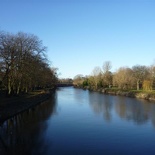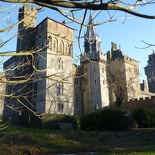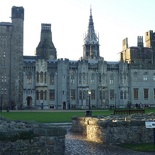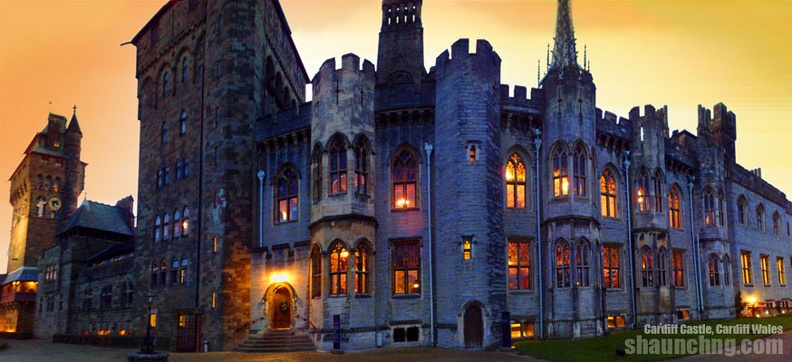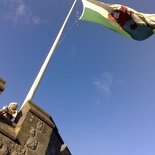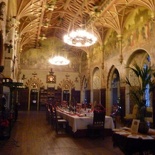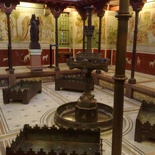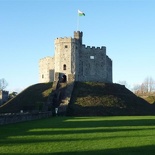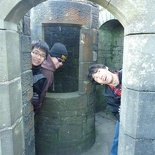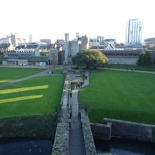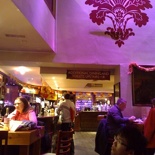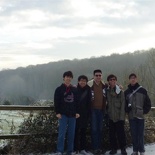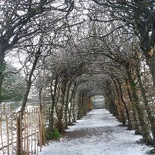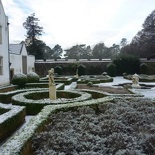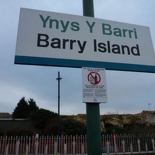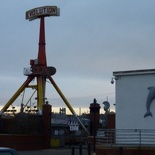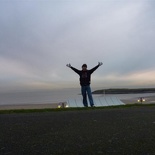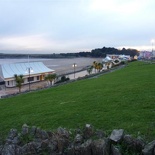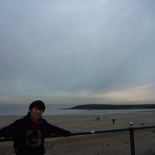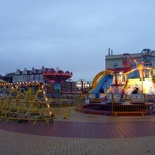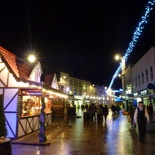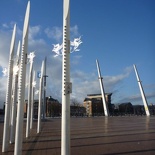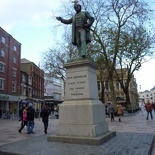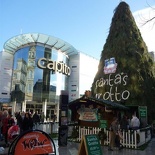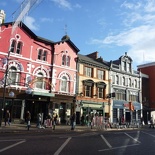In stark contrast to the modern buzzes of life in Cardiff, this second part of my Cardiff trip will cover trips to more medieval parts of town, particular the Cardiff castle and the St Fagans village and National History Museum.
The Castell Caerdydd, which most of us come to know as the Cardiff Castle is a medieval castle and Victorian architecture Gothic revival mansion. It is located right in the heart of the city of Cardiff itself just not too far off the university grounds and within walking distance from the central railway station. It is one of the main tourist attractions in the city itself and a must visit, you will have no problems finding it either- you can’t miss it with it standing out with it’s high castle walls, it’s just seem completely out of place in a modern city.
Nice open parks such as the Bute park can be found adjacent to the castle grounds, which unlike the castle grounds have no chargeable admission fee to enter. The park will bring you past the western exterior of the castle separated by a small moat and the River Taff. River cruises serve the River Taff. The Coopers field in the park itself has some stone hedge-like theming, remnants of a miniature world wonder.
The castle itself was transformed from a Norman keep erected over a Roman fort. The castle’s full high walled fortification serves more than to keep prying tourist eyes but served a more practical purpose around AD 55 during the conquest of the Silures tribe. Within the fortress wall houses a vast open field, a keep, mansion and several tunnels and observation posts, all nicely preserved till today. The Victorian mansion sits on the western site of the castle grounds, flanked by walkways linking the top of the fort walls. A stone clock tower can be found beside the castle mansion itself.
The castle was enlarged and refashioned in an early Gothic Revival style for John Crichton-Stuart, 2nd Marquess of Bute by Henry Holland in the early 19th century, but actual works only begin in 1868 when John Crichton-Stuart, (the 3rd Marquess of Bute) commissioned William Burges to undertake a massive rebuilding which turned the castle into a 19th century fantasy of a medieval palace we still see till present.
The Victorian mansion, Cardiff Castle panorama.
The mansion may look intimidating on the outside, but is a sight to behold by itself. It is actually very well preserved in comparison to the surrounding ruins and keep. It gets better in the interior too- decked with a series of rooms, hallways and fireplaces which constitute the highest achievement of later Victorian Gothic Revival design. Even the dining halls are all elaborately decorated. The mansion however has a contrasting mixture of elaborate and dark areas, which do not seem to go well with the general lavish theme, this includes the vast open carpeted walkways in comparison to the cold clammy concrete cladded “dungeon-like” narrow spiral staircases which serves the various floors including underground rooms, the library as well as the roof top open air bathing area.
Located just outside the mansion is a clock tower, which has it’s location at the south west corner of the castle fortifications. The Clock Tower was restored in 1869 and feature covered walkways which continue eastwards. Other towers in the castle grounds include the Tank Tower, the Guest Tower, the Herbert Tower and the Beauchamp Tower. There is an extensive internal tunnel network in the fortification walls that link all the towers altogether.
The trademark of the Cardiff castle will have to be the iconic Cardiff Castle Norman Keep located at the center of the castle open fields surrounded by an active moat (It’s surprising rock frozen in winter). The keep was constructed on a high knoll within the castle grounds at about 1091 by Robert Fitzhamon, lord of Gloucester and conqueror of Glamorgan, it was first uncovered during the third Marquess of Bute’s building campaign. After through the tides of time, only the other shell of the Keep remains today. Despite being in the ruins, the Keep still houses a mini courtyard and several rooms on it’s upper floors, all precariously served by steep and narrow staircases.
On a little history of the keep, after the failed attempt of Robert Curthose, duke of Normandy, William the Conqueror’s eldest son, to take England from Henry I, Robert of Normandy was imprisoned here until his death in 1134. The castle, rebuilt in stone, was an important stronghold of Marcher Lords, in the de Clare and le Despenser dynasties, also the Beauchamps Earls of Warwick, Richard of York through his marriage into the Neville family, and the Herbert family, Earls of Pembroke.
In the 18th century the castle became the property of John Stuart, 3rd Earl of Bute, who became through his Herbert wife a major landowner in the area, and whose heirs developed the docks that transformed Cardiff from a fishing village to a major coal exporting port during the 19th century. The castle very much stood the tide of time and passing, with preserved nuances of it’s military past.
The best place to buy souvenirs in Cardiff are the from the traditional small shops lined through out the town, the items here are generally much cheaper and richer in variety than those sold in the official attraction gift shops. It’s shopping for these unique Welsh items where we come to discover the eating places around town.
Cardiff is also home to few of the best pubs I’ve ever been to in the UK so far. Good here meaning great food and drink with a price and ambiance that is hard to beat. Few commendable pubs will have to be Edwards at Royal hotel, the Lifebar along St Mary’s street. A highly recommended fantastic dinner spot will include the Owain Glyndwr Pub near Market street by the castle. Here it is not uncommon to get a full main course meals at £10 or lower (Some even going at £7). Though usually meant to be shared among a pair, we usually get ahead of ourselves by ordering (and eating) 2 main courses per person. It’s quite a good deal and the food’s good! Nothing better than chilling out with a good beer after a long day of sightseeing.
Our next day saw ourselves setting up for a long bus trip out of the Cardiff bus terminals towards St Fagans. The route there is served by Veolia bus services. St Fagans (Welsh: Sain Ffagan) is an area in the west of the city of Cardiff. It is home to St Fagans National History Museum (formerly called the Museum of Welsh Life), St Fagans Castle, St Fagans Old Rectory and St Mary’s Church. The town is situated in a rather remote and snow capped area, served only by one 2 hourly bus service. Our journey saw us passing many other small neighborhoods and nucleated towns before hitting the museum entrance.
We arrived early and checked out the nearby country side while waiting for the place to open. To the south of our destination lies the village of Michaelston-super-Ely, and to the east the suburb of Fairwater. St. Fagans is home to St. Fagans Cricket Club. In 1648, the Battle of St Fagans took place close by. St Fagans lies on the River Ely, and previously had a railway station on the South Wales Main Line. The regular distant horns of passing trains reaffirms railway still active till today.
St Fagans National History Museum St Fagans Castle panorama.
On entering, picture this: being greeted by a row of nicely arranged trees planted alongside a long pathway leading to a fountain and the castle (St Fagan’s Castle) in the background finished in lush white as sparking as the snow all around. The museum is essentially an architecture museum with all the exhibits in 1x scale. It’s interesting how the museum is able to showcase various different builds of traditional houses of Wales itself. There are over forty original buildings sourced from Gwynedd, Flintshire and Worcestershire over various historical periods in Wales all re-erected in the 100-acre museum parkland. We got to visit one of the display highlights, particularly the 14th century St Fagans castle. The interior are darkwood elaborate and spacious, it’s almost like stepping back into time.
The various houses provided an insight to how Welsh Iron-Age ancestors lived in Celtic Villages. There is much to explore, but did didn’t managed to see them all, citing bummer as the attraction had to be prematurely closed due to heavy snow (it was not even snowing though, just white everywhere) cutting our stay at museum short. But on the bright side at least we did get to see some of the main highlights.
On our way back to Cardiff, we got to meet a fellow local at the bus stop who was traveling there himself too. It was there where we learnt about how notorious the bus delays can get here. Little do we know that the bus we were waiting for had broken down, leaving us stranded in the cold snow for more than 4 hours. Usually a tell tale sign of a bus coming will be people randomly popping by the bus stop at the stipulated timings of arrival, we were sickened and about to embark on a long walk back to the nearest town before this guy came to the stop.
We got to learn quite alot of local knowledge thanks to our Welsh friend. Had had some time to spare before the event with his friends, so he kept us entertained and chatty throughout our journey including introducing various nice interesting eating spots in town itself. He personally brought us to the best spot in town for traditional Welsh gifts as well as a café serving traditional Welsh food, we had something which goes on the line of Rarebit (we thought rabbit) and of course more Laver. With our tummy filled, we then made our way to our last main attraction to catch spot of the day- Barry Island.
I remembered another local university senior staying in Cardiff telling me that no one visits Barry’s island (or Ynys y Barri in Welsh) in winter. But we went ahead with the trip anyway as it’s our last planned spot which is not too far off either. It is located in part of the town of Barry in the Vale of Glamorgan, south Wales. Named after the 6th century Saint Baruc, the spot is one of the few nice beach sites transformed into a district, peninsula and seaside resort which are very popular in summer. It is rather accessible as well, it being just a short 15 minute train ride from Cardiff central railway station.
It being winter, the place was quite a dead town on our arrival. The place was creepy deserted and quiet, but awesome as well, it seems as if a zombie apocalypse had wiped the town out completely. There was not even a single soul when we arrived and got off the lone train at the station. The amusement park in front of the station was quiet and empty. It was there where we encounter the longest and one of the most slippery ice cladded pavements on the whole trip.
The highlight of Barry Island will be Whitmore Bay Beach with it’s wide open sandy beaches. The beach is long and protected by 2 natural breakwaters which shelters the bay and beach area from the sea. Surprisingly there is live at the place too. We get to see an occasional jogger or an elderly couple and a small group playing catch with their dog on the beach, but that’s very much the patrons at the beach for today.
The tides are rather low for the day too, with a reasonable 100 meter walk from the start of the beach to the beachline. There are small trails by the small hilly ridges on both ends of the beach, bringing you over the knolls with unobstructed views of the sea out of the bay area. There are no skin baring, surfing or sun bathing here at this time of the year, but the beach is a fantastic place to spend by yourself with the sound of There are some standalone amusement fairground flat rides operating by the beach itself, together with some small arcade shops and jackpots. There are few eateries in the area, but most of them are either closed for the winter or just don’t serve food within our price range. We had dinner at a nearby pub serving reasonably priced pub food by the road near the railway station. It was not necessarily the best we’ve eaten in our trip. The ambiance is decent with the exception of the continuous looping of lady gaga on the pub televisions.
We embarked on our train journey back to the central railway station, we had some bites at a local pub before heading back to the hotel for a deserving night’s rest. Our final day in Cardiff was spent catching up with exploring missed sights around the town area, particularly exploring the stretches of the River Taff beyond the Millennium stadium. That is of course not forgetting some also some last minute Christmas shopping around the capitol area after collecting our return train tickets from the Central railway station.
Cardiff Central Railway Station panorama.
Cardiff Central railway station is one of the few major British railway stations on the South Wales Main Line. It is also the largest and busiest station in Cardiff itself and in Wales, it being one of the major stations of the British rail network, being the tenth busiest station in the United Kingdom outside London serving over 11 million passengers a year. It is managed by Arriva Trains Wales and served by mainly by First Great Western trains.
There is quite a lot of shopping to do before leaving. After all it’s Christmas with many different kinds of sales and offers going on, not to mention a large variety of shopping arcades and independent shops littered all around the main city center too. St Davids is a new shopping establishment at my time of visit and spots quite several shops from major UK retailers. Notably most of the stuff sold are actually almost the same things we can find back in Cambridge, with the exception of the lower prices from the Christmas sale. We trotted down the Queens arcade, pass the Capitol center shops and John Lewis before chilling out at the pubs over lunch and catching our train departure thereafter from the Cardiff Central railway station back to London.
Cardiff is a city with a rich mix of the past and present. The lack of outdoor activities and attractions during winter was not much of a total letdown but which could have added more to our trip. But it has it’s unique perks too, such as the fantastic snow views in the white highland forests and English gardens. Ultimately the thing really memorable about Cardiff will have to be the really friendly people themselves, not to mention the fantastic pubs in the city. These itself are justifiable factors to recommend a return trip back to Cardiff again.
(You are currently viewing page 1/2)
- Page 1/2 » By the Cardiff bay, River Taff & Millennium stadium
- Page 2/2 » Barry Island & Castles in Cardiff and St Fagans
:: View more photos in my Cardiff, Wales trip photo album ::

